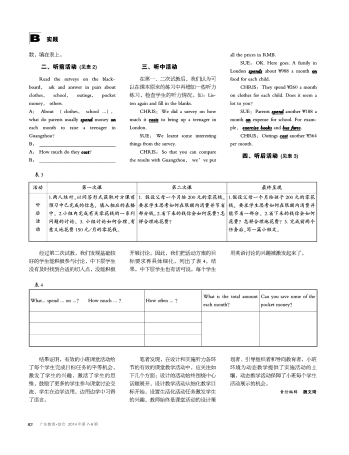二、听前活动(见表2)
Read the surveys on the blackboard, ask and answer in pairs about clothes, school, outings, pocket money, others.
A: About (clothes, school ...), what do parents usually spend money on each month to raise a teenager in Guangzhou?
B:
A: How much do they cost?
B:
三、听中活动
在第一、二次试教后,我们认为可以在课本原来的练习中再增加一些听力练习,检查学生的听力情况。如:Listen again and fill in the blanks.
CHRIS:We did a survey on how much it costs to bring up a teenager in London.
SUE:We learnt some interesting things from the survey.
CHRIS:So that you can compare the results with Guangzhou, we’ve put all the prices in RMB.
SUE:OK. Here goes. A family in London spends about ¥988 a month on food for each child.
CHRIS:They spend ¥260 a month on clothes for each child. Does it seem a lot to you?
SUE:Parents spend another ¥188 a month on expense for school. For example, exercise books and bus fares.
CHRIS:Outings cost another ¥364 per month.
四、听后活动(见表3)
经过第二次试教,我们发现基础较好的学生能积极参与讨论,中下层学生没有及时找到合适的切入点,没能积极开展讨论。因此,我们把活动方案的目标要求再具体细化,列出了表4。结果,中下层学生也有话可说,每个学生用英语讨论的兴趣被激发起来了。
结果证明,有效的小班课堂活动给了每个学生完成目标任务的平等机会,激发了学生的兴趣,激活了学生的思维,鼓励了更多的学生参与课堂讨论交流,学生在边学边用,边用边学中习得了语言。
笔者发现,在设计和实施听力各环节的有效的课堂教学活动中,应关注如下几个方面:设计的活动始终围绕中心话题展开,设计教学活动从细化教学目标开始,设置生活化活动任务激发学生的兴趣,教师始终是课堂活动的设计策划者、引导组织者和导向教育者,小班环境为动态教学提供了实施活动的土壤,动态教学活动保障了小班每个学生活动展示的机会。
责任编辑 魏文琦




